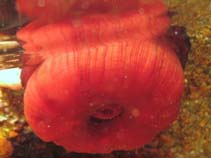Actinia equina (Linnaeus, 1758)
Beadlet anemoneWarning: DOMDocument::load(): SSL operation failed with code 1. OpenSSL Error messages: error:140770FC:SSL routines:SSL23_GET_SERVER_HELLO:unknown protocol in C:\Apache24\htdocs\includes\SpeciesSummary.lib.php on line 1236
Warning: DOMDocument::load(): Failed to enable crypto in C:\Apache24\htdocs\includes\SpeciesSummary.lib.php on line 1236
Warning: DOMDocument::load(https://sealifebase.nrm.se/webservice/AquaMaps/getAMap.php?genus=Actinia&species=equina): failed to open stream: operation failed in C:\Apache24\htdocs\includes\SpeciesSummary.lib.php on line 1236
Warning: DOMDocument::load(): I/O warning : failed to load external entity "https://sealifebase.nrm.se/webservice/AquaMaps/getAMap.php?genus=Actinia&species=equina" in C:\Apache24\htdocs\includes\SpeciesSummary.lib.php on line 1236
Classification / Names Common names | Synonyms | CoL | ITIS | WoRMS
| Actiniaria | Actiniidae
Environment: milieu / climate zone / depth range / distribution range Ecologia
; intervalo de profundidade 0 - 1600 m (Ref. 108103). Subtropical; 73°N - 36°S, 26°W - 143°E
Distribuição Países | Áreas FAO | Ecossistemas | Ocorrências | Introduções
North and South Atlantic, Mediterranean and Pacific: From Atlantic Europe to northern Russia, the Mediterranan, South Africa and Japan.
Length at first maturity / Tamanho / Peso / Idade
Maturity: Lm ? range ? - ? cm Max length : 8.0 cm H macho/indeterminado; (Ref. 363)
Approximately 6 to 8 cm in height and less than 10 cm in diameter in extension (Ref. 363). Occurs at the water line, especially in sheltered places such as the inside of harbor walls (green Actinia), red Actinia can occasionally be encountered in the intertidal zone of Azores (Ref. 201)); Common run on the rocks, the surface to a few meters of depth (Ref. 363). Also found in infralittoral zones (Ref. 85338). Solitary (Ref. 2377).
Life cycle and mating behavior Maturidade | Reprodução | Desova | Ovos | Fecundidade | Larvas
Members of the class Anthozoa are either gonochoric or hermaphroditic. Mature gametes are shed into the coelenteron and spawned through the mouth. Life cycle: The zygote develops into a planktonic planula larva. Metamorphosis begins with early morphogenesis of tentacles, septa and pharynx before larval settlement on the aboral end.
Referência principal
Referências | Coordenador | Colaboradores
Wirtz, P., O. Ocaña and T. Molodtsova. 2003. (Ref. 201)
Status na Lista Vermelha da IUCN (Ref. 130435)
Status no CITES (Ref. 108899)
Not Evaluated
CMS (Ref. 116361)
Not Evaluated
Perigo para os humanos
Uso pelos humanos
| FishSource |
Ferramentas
Mais informação
Fontes da internet
BHL | BOLD Systems | CISTI | DiscoverLife | FAO(Publication : search) | Fishipedia | GenBank (genoma, nucleotídeo) | GloBI | Gomexsi | Google Books | Google Scholar | Google | PubMed | Hexacorallians of the World | Árvore da vida | Wikipedia (Ir para, procura) | Registro zoológico
Estimates based on models
Preferred temperature
(Ref. 115969): 0.6 - 14.2, mean 7.8 (based on 456 cells).
Categoria de preço
(Ref. 80766):
Unknown.



